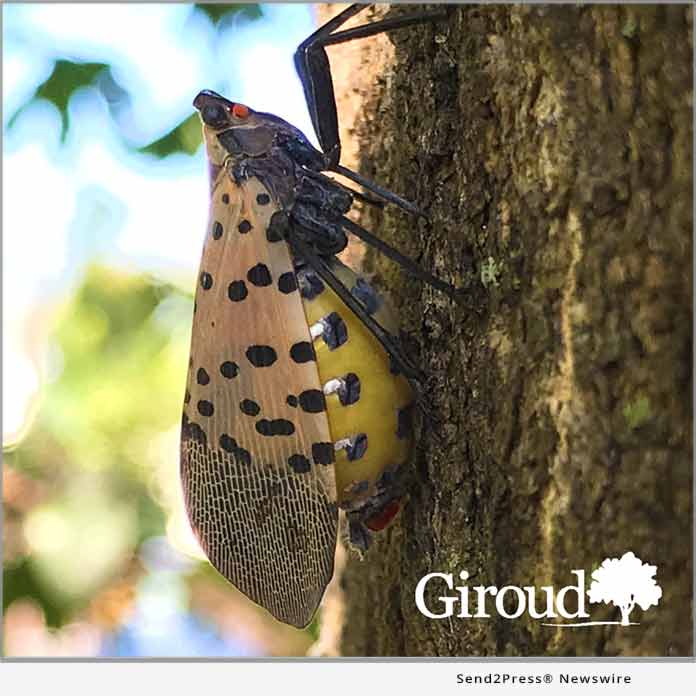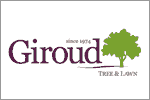HUNTINGDON VALLEY, Pa., Oct. 7, 2019 (SEND2PRESS NEWSWIRE) — Now that the cooler fall weather is here, the adult Spotted Lanternfly are dying off, but not before laying thousands of eggs which will hatch next spring. Many homeowners are wondering what the government is doing to control the invasive insect. The experts at Giroud Tree and Lawn explain what Pennsylvania is doing to combat Spotted Lanternfly and show homeowners how to remove and destroy Spotted Lanternfly Egg Masses in an instructional video.

PHOTO CAPTION: A female Spotted Lanternfly with a large, yellow belly is ready to lay her eggs. She will cover the masses in a protective clay-like substance and her nymphs will hatch next spring.
There are three main players in the fight against Spotted Lanternfly here in Pennsylvania: the Pennsylvania Department of Agriculture (PDA), the United States Department of Agriculture (USDA), and Penn State College of Agricultural Sciences. Working together, they have been spreading the word about the dangers of this insect to our ecosystem and to homeowners.
Penn State has been researching this insect since it first appeared in the US back in 2014. The hard work done by Emeilie Swackhamer, Penn State Horticulture Director, and her team has been instrumental in understanding how the Spotted Lanternfly is causing damage and how to combat it. She explains in an informational YouTube video that while it’s still too early to say what the long-term effects will be, the insects are definitely causing significant die-back and defoliating branches in trees.
The PDA has been working hard to control the insect within the state. They have outlined their efforts on their website as follows:
“The (PDA) has taken on the role of control and treatment and hired more than 20 field staff to:
- Place sticky bands in more than 10,000 locations
- Issue nearly one million permits to more than 17,000 companies
- Survey for Spotted Lanternfly in all 67 counties (33,000 documented points)
- Establish a 14-county quarantine zone
- Kill more than 71,000 Tree of Heaven
- Establish hundreds of trap trees (Tree of Heaven that are left alive and treated with insecticide to kill SLF feeding on the trees)”
The USDA has also been attempting to figure out how to control the insect, even going so far as to import predator wasps from China to test the idea of introducing another invasive insect in order to control this one. However, these trials can take time and they need to research every possible outcome before taking such a measure.
Fred Strathmeyer, Deputy Secretary for Plant Industry and Consumer Protection for PDA, explains the possible negative ramifications in a recent article on PhillyMag.com. “Unleashing (a predator insect), or napalm, or any of the other drastic measures folks have suggested would also devastate the environment, and harm pets and humans and other crops.”
How Homeowners Can Help Combat the Spotted Lanternfly Invasion
In an instructional YouTube video, Giroud Tree and Lawn explains what to look for and how to remove and destroy Spotted Lanternfly Egg Masses.
There are 3 important steps homeowners should take if they see Spotted Lanternfly egg masses in the property:
- Scrape the egg masses from any surfaces using a credit card.
- Destroy the eggs by dumping the egg masses and any debris into a bottle or bag with rubbing alcohol or hand sanitizer.
- Report any findings online at http://www.extension.psu.edu/have-you-seen-a-spotted-lanternflyor call the Spotted Lanternfly hotline 1-888-422-3359.
Where to Find Spotted Lanternfly Egg Masses
The first place to look for egg masses is on the undersides of branches of trees where Spotted Lanternfly are feeding. However, these tricky insects will actually lay eggs on virtually any smooth surface, typically on the undersides where the egg masses are better protected from predators.
Egg masses can be found on:
- Benches
- Stones
- Firewood
- Cars
- Playsets
- Railings
- Outdoor Grills
- Patio Furniture
When In Doubt, Call a Certified Arborist
If homeowners have any questions about suspicious masses or any other evidence of Spotted Lanternfly on the property, they should call an ISA Certified Arborist to evaluate the property and look for signs of the insect.
About Giroud Tree and Lawn
Giroud Tree and Lawn specializes in tree service, lawn care and mosquito and tick control programs that make customers love doing business with the company since 1974. Serving Bucks, Montgomery and Philadelphia Counties, the company offers professional tree and lawn evaluation, tree pruning, tree removal, insect and disease control, fertilizing, stump removal, traditional and 100% organic lawn programs and mosquito and tick control.
Giroud Arborists are certified by the International Society of Arboriculture (ISA) and have the knowledge and experience required to properly diagnose, treat and maintain trees and lawn health. The company is Accredited by the Tree Care Industry Association and Better Business Bureau. Giroud has also been awarded the Angie’s List Super Service Award® every year since 2005. The “Giroud Treework for Charity” program donates free tree care services to parks, historical sites and other non-profit organizations located in the Company’s service area. For more information, visit the company website at http://www.giroudtree.com or call 215-682-7704.
News Source: Giroud Tree and Lawn
